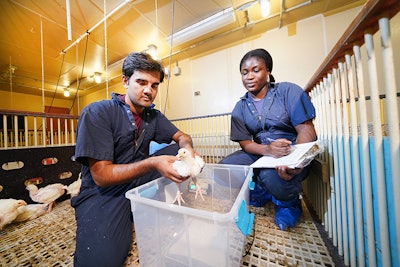
Cage-free layers could soon be able to better cope with northern fowl mite, one of the costliest parasites to affect the U.S. egg industry, and the poultry industry may gain a better understanding of lighting in commercial duck barns, following grant funding awarded to Purdue University.
The grants, amounting to US$1.4 million, were awarded to two separate research projects led by Marisa Erasmus, Perdue Associate Professor of Animal Sciences, and Gregory Fraley, Perdue’s Terry and Sandra Tucker Endowed Chair of Poultry Science.
Erasmus’s research will determine if cage-free layers can be genetically predisposed to fight the northern fowl mite, a parasite known to threaten hen welfare, and Fraley’s will investigate how ducks perceive light in commercial systems.
Laying hens, parasites and cage free
According to Erasmus, there is variation among individual laying hens’ response to the northern fowl mite, which opens the possibility of a genetic or genomic solution to the problem.
Erasmus and her research team plan to gain an understanding of how individual hens differ in their ability to resist mite infestations and determine if birds can be bred to be more resistant to external parasites.
“One of the major health issues for laying hens is external parasites, but hens do not all respond to parasites in the same way,” Erasmus said. “Even though they look very similar, chickens have individual responses, and some are more susceptible to parasites than others.”
Another portion of Erasmus’s research focuses on the U.S. egg industry’s shift to cage-free housing.
“Controlling pests in cage-free systems is more complicated and challenging than in cages,” Erasmus stated. “These types of parasites are resistant to some insecticides. And we’re limited as to insecticides that can be used while making a product that’s going to be food for human consumption.”
Duck welfare
Poultry are seasonal breeders, meaning they need long days, or specific lighting strategies, to lay eggs.
According to Fraley, little consideration has been given to the lighting in commercial duck barns.
“Most of the lighting systems are designed for the benefit of the people that work with the animals, not really taking into consideration how it may affect the animals’ perception of their environment,” Fraley said.
Bird eyes have multiple types of color receptors compared to human eyes. Additionally, birds can see ultraviolet colors and potentially some infrared.
“There is absolutely nothing in our human experience that can prepare us to understand how a bird visualizes its environment,” Fraley said.
Fraley and his team plan to investigate lighting from the duck's point of view and potentially determine optimal lighting systems to improve reproductive performance and welfare in commercial barns.











